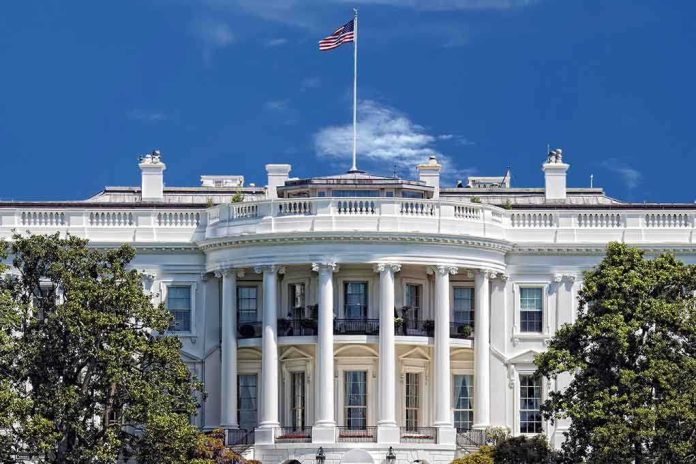
What if the White House—the most iconic symbol of American continuity—could be forever changed, not by time or tragedy, but by a single president’s ambition to make it his own?
Story Snapshot
- Trump’s sweeping renovations break a centuries-old tradition of White House preservation.
- A $200 million privately funded ballroom redefines the mansion’s historic East Wing.
- Critics warn these changes set a precedent for unchecked presidential personalization.
- The debate spotlights the tension between executive power and public stewardship of national heritage.
Trump’s Transformation: The End of a Presidential Tradition?
Donald Trump’s White House renovations have upended the unwritten rule that presidents are caretakers, not owners, of America’s most storied residence. The new 90,000-square-foot ballroom, already under construction and privately funded, extends into the East Wing, dwarfing previous modifications and raising eyebrows among historians and the public alike. For critics, this is not just an architectural statement—it’s a rupture in the American tradition of respectful, reversible stewardship of the nation’s most sacred civic home.
Since John Adams first moved in, presidents have tweaked the White House to suit their needs, but always with an eye toward preserving its historical essence. Theodore Roosevelt’s West Wing modernization, Harry Truman’s mid-century rebuild, and Jacqueline Kennedy’s restoration all reflected a careful balance between modernization and heritage. Trump’s ballroom, however, represents a scale and ambition unmatched by any predecessor—a personal monument in marble and gold, designed to bear his stamp for generations.
Why This Renovation Is Different from All the Rest
Prior White House changes, whether Nixon’s bowling alley or Obama’s garden, were modest, reversible, and generally aimed at improving function or restoring lost history. Trump’s approach is fundamentally different. His modifications to the Rose Garden—reshaped paving, stark umbrellas, gilded trimmings—and the ongoing ballroom construction suggest a taste for spectacle and permanence. Supporters argue that private funding justifies the scale, but preservationists warn that money is not a substitute for historical integrity. The White House, they argue, is not a blank canvas for presidential branding, but a living symbol of democracy’s endurance.
Trump Is Destroying One of America’s Oldest Traditions – The Atlantic https://t.co/KEjyWCBdau
— Michael F Ozaki MD (@brontyman) October 8, 2025
The White House Historical Association and National Park Service, typically the final word in preservation, have been forced to adapt to a new reality: the president now wields near-total authority over renovations, constrained only by tradition and public scrutiny. The tension between executive privilege and the stewardship expected by the American people has never been sharper. Critics see Trump’s renovations as a test of whether any part of the nation’s heritage is truly off-limits to personal ambition.
The Politics of Private Money and Presidential Ego
The scale of Trump’s changes is matched only by the controversy over how they are funded. The ballroom’s $200 million price tag is covered not by taxpayers, but by a cadre of private donors, some with obvious political and business interests. This precedent—privately financing public heritage—raises uncomfortable questions. Preservationists worry about the influence such donors may exert and the risks of turning national monuments into billboards for the highest bidder or the most determined president. The White House, once a symbol of shared history, may be drifting toward privatization by stealth, one renovation at a time.
Historians and political scientists point to a deeper cultural shift. The tradition of modest, reversible changes reflected a belief that the White House outlasts any one administration. Trump’s renovations defy this ethic, betting that the future will accept—if not embrace—a new, more personalized vision of American heritage. Supporters argue that all presidents leave their marks, and that Trump’s changes are simply bolder and more memorable. Yet for many, the sheer scale and spectacle of these modifications risk transforming a national symbol into a personal legacy project.
What Comes Next: Symbolism, Precedent, and the American Identity
Construction on the ballroom continues, with completion expected next year. The Rose Garden and Oval Office already reflect Trump’s stylistic preferences. The White House now stands at a crossroads: will future presidents feel empowered to make similarly sweeping changes, or will public outcry restore the old ethic of stewardship and restraint? The answer will shape not just the building, but the story Americans tell about their democracy and its endurance.
What is certain is that the debate is not just about architecture—it’s about values. The White House is more than stone and paint; it is a living testament to the balance between leadership and legacy, innovation and tradition. Trump’s renovations have forced the nation to confront an uncomfortable question: how much of our shared heritage are we willing to trade for the sake of one man’s vision?
Sources:
Fox17: Fact check on Trump’s White House changes
Fox News: Kamala Harris on Trump Admin










